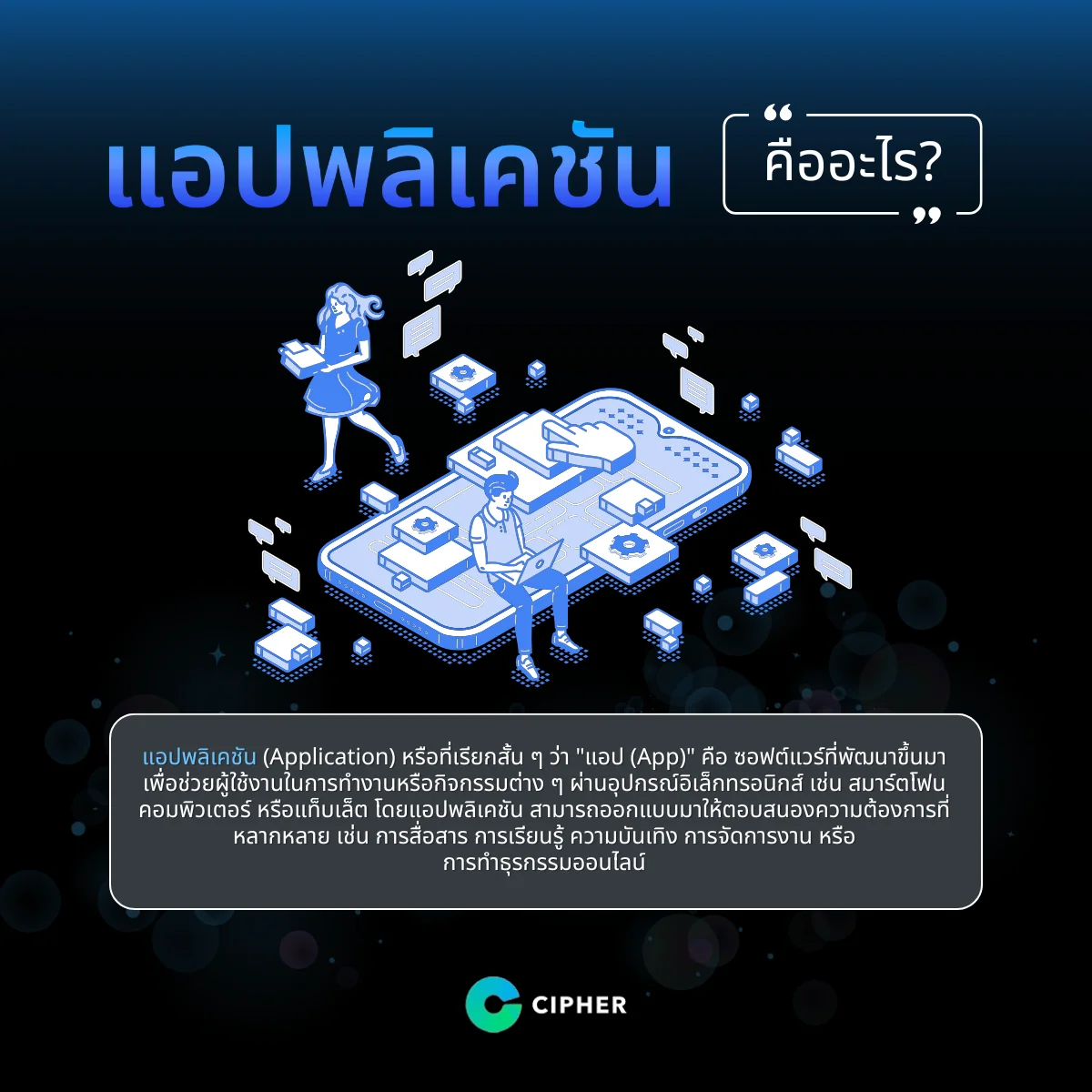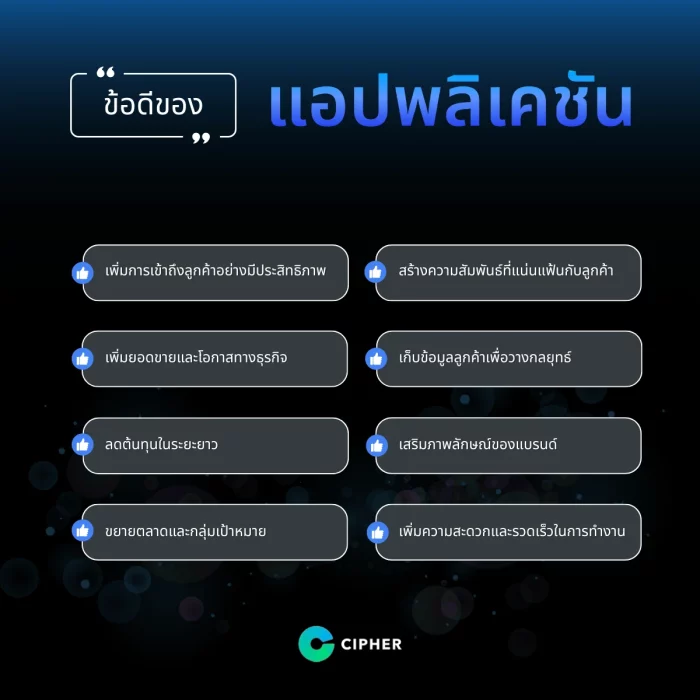Table of Contents
How do mobile applications create mobile apps for businesses? ? To be successful.
When it comes to mobile applications, it’s undeniable that “app” has become an important tool to drive business growth and compete in ever-changing markets. Whether you’re a small business or a large organization, mobile apps can improve customer service efficiency, create impressive experiences, and open new opportunities for business revenue.
CIPHER, an iOS and Android mobile application specialist, is ready to help your business develop apps that meet their needs and goals by leveraging cutting-edge technology and detailed design, not only creating easy-to-use apps, but also strengthening business capabilities in this competitive era. We’ll introduce you to applications, tools that help you grow your business even more!
The application is What?

An application, also known as an app, is a software developed to help users perform tasks or activities through electronic devices such as smartphones, computers, or tablets. Applications can be designed to meet a variety of needs, such as communication, learning, entertainment, job management or online transactions.
Applications include both deployable models, such as iOS or Android mobile applications and Web applications. Application usage can help make life easier, often with an easy-to-use interface and customizable functions.
Applications have categories. Anything?
Applications can be divided into several categories based on their usage characteristics and platforms supported by the three main categories, which have different uses depending on the user’s needs and the nature of the tasks to be performed as follows:
1. Mobile Application
Mobile Application is a mobile application developed for use on mobile phones or tablets. Most of them support Android and iOS operating systems. This type of app can be downloaded from online stores or stores of each mobile operating system, such as Google Play Store or Apple App Store, a collection of mobile apps. Examples of mobile apps such as
- Social media apps like Facebook and Instagram.
- Bank apps like SCB Easy.
- Mobile apps for communication such as LINE
- A mobile app for gaming.
2. Desktop Application
Desktop Application is an application designed for use on a computer (PC) or laptop. For example, Microsoft Word, Adobe Photoshop, or Visual Studio Code coding programs. These applications must often be installed into operating systems such as Windows, macOS, or Linux to use.
3. Web Application
Web Application is an application that runs through a web browser without installation, such as Gmail, Google Docs, or online store management. Many apps are designed to be available from mobile apps by loading mobile apps or mobile versions. Web Application is suitable for accessing from multiple devices. Only Internet connectivity and supported browsers.
Types of mobile applications for businesses
Making mobile apps is something that businesses should not overlook. Because the behavior of the Internet has become more active. As a result, activities require applications. Mobile phone applications for business can be divided into 3 main types as follows:
Native Applications
Native Applications are applications developed exclusively for a particular operating system, such as iOS or Android, using appropriate programming languages such as Swift (for iOS) or Kotlin and Java (for Android). These apps have the highest performance and full access to hardware features in the device, such as cameras, GPS, or other sensors.
Native Applications are ideal for businesses that want to provide the best user experience, such as bank apps (SCB Easy) or online shopping apps (Lazada).
Web Applications
Web Applications is an application that runs through a web browser without installing it on a mobile device. Developed with web technologies such as HTML, CSS and JavaScript in creating apps. The advantage of this type of app is that it can be used on a variety of devices without developing multiple versions. It is suitable for businesses that need to access multiple platform users without developing specific apps. But the disadvantage is that it may not complete all features in the device.
Hybrid Applications
Hybrid Applications is an application developed with web technology (HTML, CSS, and other applications). JavaScript) But it uses frameworks such as Ionic or React Native to create apps to enable apps to run on multiple platforms like Native Applications. The advantage of this type of app is a one-time development that works both iOS and Android and has various interactive features like mobile apps to feel like they are using mobile apps. Performance may not be equivalent to Native Applications.
Benefits of Applications to Businesses and Consumers
Applications are important tools that help create mutual benefits between businesses and consumers in improving relationships and improving service efficiency.
Application Benefits to Business
- Increase sales channels and customer access:
Applications enable businesses to reach customers 24/7 through smartphones or tablets, increasing sales opportunities and services. - Establish relationships and participation:
Push notification allows customers to communicate information, promotions or important information more accurately and in a timely manner. - Strengthen image and credibility:
Having an easy-to-use, modern application helps build brand confidence and demonstrate a commitment to customer service. - Collect data for analysis:
Businesses can capture customer behaviour information to improve their products or strategize their marketing strategies effectively. - Reduce long-term costs:
Applications reduce the cost of managing services such as communication, queuing, or online transactions.
Application Benefits to Consumers
- Improve convenience: Consumers can access their products and services anytime, anywhere, whether they’re ordering online, booking services or paying.
- Save time: Applications reduce complicated processes such as filling in data or queuing with a fast online system.
- Personalize Personal Experience: Using user information, the app can introduce products and services that fit your interests, such as special offers or personalized advice.
- Easy access to information and services: Consumers can instantly find information, review products, or compare prices through an app.
- Increase confidence in use: Secure apps help consumers ensure financial transactions and personal information delivery.
What are the advantages of the application? Any?
The application has advantages to the business in many ways. It helps to promote operations, service and customer relationships as follows:

1. increase effective customer access
Applications allow customers to connect directly to their business through smartphones or tablets. Customers can travel to the front of the store and access product and service information anytime, anywhere, such as browsing product catalogs, checking order status or booking services in advance.
2. build strong customer relationships
Businesses can continue to use applications to communicate with their customers, such as special promotional alerts, new product introductions, or personal messaging. The Loyalty Program feature in the app also encourages re-use of services such as collecting points for discounts.
3. Increase sales and business opportunities
The availability of applications increases product and service opportunities with advanced features such as online payment systems, home delivery, and personalized special offers such as discounts based on customer buying behavior.
4. collect customer information for strategy
Applications can capture important customer information, such as demographics, product searches, and customer time. This information helps businesses analyze customer behavior, plan specific marketing plans, and tailor products or services to meet their needs.
5. reduce costs in the long run
Having an application reduces costs in many parts, such as reducing the cost of printing brochures, managing automated service reservation systems, or reducing the number of employees required in service tasks, as customers can perform certain actions manually through apps such as queue reservations or payments.
6. enhance the brand image
7. expand the market and its target audience
Applications allow businesses to reach their target groups around the world without being limited by physical space. For example, online shops that can deliver goods to overseas customers or service reservations that allow businesses to attract tourists from around the world.
8. make it easier and faster to do the work
Using applications, businesses can effectively manage processes such as real-time order management, delivery status tracking, and automated alerts that help keep teams from missing important tasks.
How to create a business-beneficial application
Creating an application requires a working process from analysis of the target group to follow-up to obtain a business-beneficial application. The way to create a business-beneficial application is as follows:
Target Cluster Requirements Analysis
Target group requirements analysis is the first step that is most important because it will help orient application development to meet user requirements and enable business-friendly and targeted applications. The first thing to do is:
1. Study the profile of the target group.
- Analysis of population data such as age, gender, occupation and smartphone usage behavior
- Specify which target groups are required. Anything from the app, such as comfort, troubleshooting found problems, or a new experience?
2. do market research
- Ask the customer for feedback through a questionnaire or an interview.
- Analysis of competitors and learn the strengths and weaknesses of existing apps in the market.
3. Define problems and solutions.
- Identifying the problems that customers are facing, such as difficult online ordering or inconvenient product information.
- Create features that help solve those problems, such as fast search systems or reservations for services through apps.
Application Design
Application design (UI/UX Design) is an important step that helps attract users and smooth the user experience. By creating applications, attention should be paid to these things.
1. UI Design
- It uses a simple and beautiful design with a focus on simple applications.
- Use colors, fonts and logos that correspond to business brands.
2. User Experience Planning (UX)
- Make the application process quick and easy to understand, such as reducing the number of clicks in the process.
- Add user-friendly features such as an easily accessible menu or non-disruptive notification system.
3. Use Mobile-First Design Concepts
- Designed specifically for mobile devices to suit the size of the screen and usage of the mobile phone.
choose the right technology
- Select the type of application that is appropriate for the business, such as Native, Web, or Hybrid.
- Use advanced technologies and frameworks such as React Native, Flutter or Progressive Web App (PWA).
Develop features that meet usage requirements
- Add key features such as online payment, notification, point collection, or search function.
- Ensure that the application is adaptable to multiple devices.
give a thorough test of one's use
- Test the app at every step to correct errors or bugs and check performance.
- Use testing from target groups or physical users to get feedback and optimize applications that are useful to the business and meet the needs of target groups.
Launch and Promote an Application
- Launch the official app in the App Store or Google Play with a clear explanation and use attractive images.
- Use online marketing such as social media ads, email, and websites to promote apps and have the target audience load the phone apps.
Continuous updates and improvements
- Collect client usage data and listen for comments to update the application.
- Update new features to meet changing customer needs and new marketing trends.
5 Mobile Application Development Steps
Mobile application development is something that developers need to focus on from planning to tracking results to develop and improve the quality of use. Mobile app design has the following key steps:

1. Planning and Setting Goals
- Identify the main objectives of the app, such as wanting to increase sales, expand customer base, or improve service delivery.
- Clearly define target groups such as age, interest, and usage behavior.
- Create a Roadmap to plan the development process from the beginning to the launch.
2. Application Design (UI/UX Design)
- UI (User Interface): Design app look beautiful, easy to use and conform to business brand.
- UX (User Experience): Plan with a focus on user experience such as simplifying menus to search for or simplifying complicated procedures.
3. Choosing a platform model to develop applications
- Choose development platforms such as Native App for development for iOS and Android.
- Verify that the app supports display on multiple devices.
4. Testing and improvement
- Test apps for errors and improve performance.
- Use tests from the target audience, such as Beta Testing, to obtain feedback and improvements based on user preferences.
- Test the operation of the app in situations such as unstable Internet connection.
5. launch and development
- Publish apps on the App Store and Google Play with compelling and vivid descriptions.
- Promote apps through marketing channels such as social media, email or websites.
- Continuously monitor app usage and update apps to add new features or resolve issues based on user opinion.
Why develop a mobile application with CIPHER?
The development of mobile applications with Cipher enables your business to be serviced by a team of experts who have experience in making mobile apps that meet all requirements, whether they are.
- Unique, easy-to-use design (UI/UX) to the development of advanced features suitable for specific businesses.
- Leverage cutting-edge technology to create high-performance, versatile applications that can scale to meet future business needs.
- The CIPHER specialization includes a team of experts with experience in developing applications that meet the needs of a wide range of businesses.
In addition, CIPHER provides a comprehensive range of services, from planning and design to post-launch management, to ensure that your apps meet the changing needs of users and markets, choosing to make mobile apps with CIPHER. Partnering in app development simplifies management and increases opportunities to create apps that maximize the return and satisfaction of your customers.
Frequently Asked Questions
For business owners who want to create mobile apps for business purposes, there may be questions about mobile apps and we have collected the following information:
The meaning and key characteristics of the application are: What?
Application refers to a software program developed to allow users to perform or perform activities on electronic devices such as computers, mobile phones, or tablets. The key characteristics of the application are:
- Focus on specific applications such as communication, transaction, or entertainment.
- Designed for ease of use with a user-friendly interface
- It is supported on a variety of platforms such as iOS, Android, and Windows.
- Connect to the Internet or other systems to improve performance.
What is the significance of the process for developing an application? ?
The application development process is important because it enables systematic and efficient application creation, starting with planning for clear goals, user-friendly design, appropriate technology development, testing for error correction, and successful rollout.
These processes can help reduce the risk of wasting budget on unnecessary costs, and enable high-quality developed apps to meet user needs, and to continue to improve and develop in the future.
Application created for What?
Applications are built to facilitate user work or activities such as communication, information management, entertainment, and transaction, focusing on solving problems and improving productivity in everyday or business life through digital devices such as smartphones, tablets and computers.





